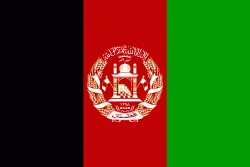Ghorband District (Siyāhgird Ghōrband)
Historically the Ghorband River valley was connected with Bactria as far back as Alexander the Great times. The ancient Koh Daman valley is an important archaeological site and evidence has revealed that the people inhabiting the valley developed sophisticated mining techniques early on.
The Ghorband valley was once inhabited by the Kheshgi Dynasty of Mughals and the Hazara people.
Prominent scholars and politicians have risen from this district. For example, Mr. Mir Ali Gouhar Ghorbandi the outspoken member of parliament during the reign of King Zahir Shah came from this district. Mr. Mir Ali Gouhar along with a group of well-known Afghan scholars including Alama and poet Balkhi attempted an unsuccessful coup d'état against the establishment of King Zahir Shah in which Mr. Mir Ali Gouhar along with the rest of the group were caught while plotting the coup d'état. After having served nearly 15 years as a political prisoner, Mir Ali Gouhar was subsequently elected by the people of Ghorband as their district representative and MP in the parliament. As an outspoken MP, he introduced number of positive progressive changes to the district. Notably, he donated his own house to be used as a girl's high school. The first of its kind the district had ever seen. Due to his political influence, the introduction of electricity and piped running water projects were implemented in the district. To this day, his legacy lives not only amongst the people of district, but across a wide spectrum of the public in different parts of Afghanistan, particularly in the central and northern regions. People of Ghorband also fought Jihad in Soviet-Union attack. Prof.Mohammad Saber Khishki (پوهاند محمد صابر خویشکۍ) a very senior Venerable professor of Kabul university and a well-known personality was born in Ghorband who served Afghans in very hard circumstances of war and conflicts, continued to teach nonstop able by considering the fact that "Encouragement of higher education for our youth is critical to the success of our collective future". . Youth are leaving no stone unturned in making Ghorband one of the pioneer province of Afghanistan.
In November 2007, a team of facilitators from the National Area-Based Development Programme (NABDP) of the Ministry of Rural Rehabilitation and Development (MRRD) and United Nations Development Programme (UNDP) assessed the district and drew up development plans. The Taliban have been active in the district. In November 2010 it was reported that two Iranian Secret Intelligence agents arrived in Syagird town in Ghorband District and were accused by the US of helping insurgents to attack coalition forces.
After the end of the three-day Eid ceasefire announced by the Taliban, which lasted from 24 to 26 May 2020, the Taliban attacked a checkpoint in Ghorband District late in the night of 27 May. This was the first deadly attack by the Taliban after the ceasefire in the country. They set fire to the checkpoint, which killed five Afghan troops, and shot dead two others. One other soldier was injured in the attack and two others were held captive, while one Taliban attacker was also killed.
Map - Ghorband District (Siyāhgird Ghōrband)
Map
Country - Afghanistan
 |
 |
| Flag of Afghanistan | |
Human habitation in Afghanistan dates back to the Middle Paleolithic era, and the country's strategic location along the historic Silk Road has led it to being described, picturesquely, as the ‘roundabout of the ancient world’. Popularly referred to as the graveyard of empires, the land has historically been home to various peoples and has witnessed numerous military campaigns, including those by the Persians, Alexander the Great, the Maurya Empire, Arab Muslims, the Mongols, the British, the Soviet Union, and most recently by a US-led coalition. Afghanistan also served as the source from which the Greco-Bactrians and the Mughals, amongst others, rose to form major empires. The various conquests and periods in both the Iranian and Indian cultural spheres made the area a center for Zoroastrianism, Buddhism, Hinduism, and later Islam throughout history.
Currency / Language
| ISO | Currency | Symbol | Significant figures |
|---|---|---|---|
| AFN | Afghan afghani | Ø‹ | 2 |
| ISO | Language |
|---|---|
| PS | Pashto language |
| FA | Persian language |
| TK | Turkmen language |
| UZ | Uzbek language |















